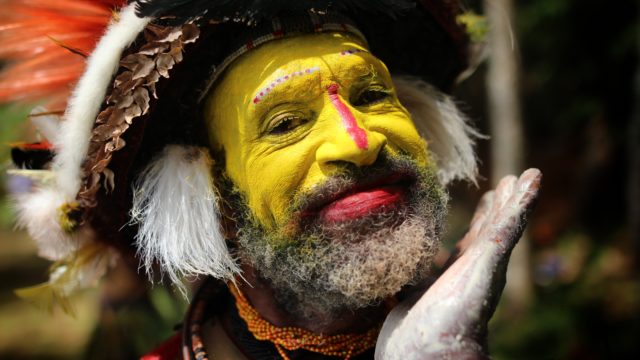
Mount Hagen
My trip to Papua New Guinea continued with the ventured to the Western Highlands via another few flights, eventually landing in Mount Hagen with time to spare before the Mount Hagen Sing Sing Show. Due to exclusively visual flight landing capability (no computers) and frequent poor visibility conditions, it is advisable to plan on arriving with several days to spare to avoid missing the show should flight plans change.

EXPERIENCE
Our time in the Western Highlands was culturally incredible. It was also amuck cooler and less humid relief from our time on the Sepik. My local guide, Mr. Pym introduced us to the region with a visit to his village, Paiya, about 40 minutes drive from Mount Hagen. During this initial visit we had a chance to let out guard down, as it was safe in the village and enjoy a little intimate discussion with three of the key cultural groups: the Skeleton Men, Huli Wigmen and Mud Men. This was a great opportunity to meet the men behind the paint and capture some great images of the costumes coming to life before our very eyes.

The following day we returned to Paiya village for what Pym has dubbed the Paiya Mini Show. On this day nearly 1 in Mount Hagen. The weather here is considerably cooler which is a lovely treat after several days in the Sepik. If possible, I would suggest sequencing you’re trip this way so things become progressively more comfortable as the days pass.

TRIBAL CULTURE NOTES
THE SKELETON MEN
The skeleton men reign from PNG’s Simbu province. Much mystique surrounds these valley tribesmen who until recently remained completely isolated. They are locally famous for their black and white body paint topped with spectacular feathered headdresses, initially intended to scare off enemies in times of war.


THE ASARO MUD MEN
The mud men have a relatively simple battle costume of white body clay, giant bamboo fingernails and dried clay masks adorned with boar tusks. Legend states that ages ago when the tribe had to flee to the river upon ambush, they scared their attackers off when they emerged like ghosts covered in white mud. These clans come from the Eastern Highlands Province and compete fiercely for honor. Each mask weighs about ten kilos.

THE HULI WIGMEN
One of the most decadent indigenous cultures are these fellows from Huli Province adorned with environmental costume, influenced in particular by the radiant birds of paradise. The Huli tribe is unique in that it’s chiefs are chosen based on battle merit, wealth and conflict resolution rather than lineage. This group has begun to feel the modern influence but still measure wealth in pigs.
Men and women of the Huli tribe do not live together. Boys leave their mothers at eight to learn to build and hunt and are expected to spend long amounts of time alone in the jungle to become brave as a rite of passage into manhood. The Huli Wigmen must craft their wigs before marriage. At age 14 the virgin Huli boys go to Wig School for the cost of one pig. Here the wig master oversees a cleansing diet, free of pork fat and spice, to prep the body and soul. He performs rituals and magic spells to encourage healthy hair growth and grooms the boy’s hair which will be the foundation for his wig. For 18 months the Huli boys must sleep in a special head dress to prevent the hair from getting flattened before it is cut and woven into a wig by a specialized elder. The wigs are enhanced with bird of paradise feathers, yellow daisies and possum fur. After wig school the face is painted yellow and the boy can go in search of a bride. A unique and distinctive yellow clay called Ambua is used to paint the faces of the Huli Wigmen.


THE CHAMBRI TRIBE
The men from East Sepik Province sport the iconic crocodile marks all over their backs intended to resemble reptile scales and teeth. These keloid scars are imposed by their mother’s brothers with bamboo slivers, tree oil, smoke and clay in a traditional initiation ceremony celebrating their transition to manhood. The rite of passage is said to be excruciatingly painful. The legend says the tribe descended from ancient crocodiles that crawled out of the Sepik River and became men. Legend has it, that those who have gone to live with the mighty crocodiles become very strong.

STAY
While I usually omit scathing hotel reviews from the blog, I feel compelled to provide warning about the Hotel Highlander in amount Hagen simply because they are charging expensive western prices and running a disaster of am establishment. The biggest tragedy about this hotel is that it is actually the nicest place to stay in all of Mount Hagen and does have close proximity to the Mount Hagen Sing Sing Grounds, so sadly it is still the “best” option.

EAT
Food stayed at a real low point throughout our time in Mount Hagen. When in Paiya Village we were fed cheese and cracker sandwiches, pineapple and bananas which went over quite well. The hotel got a few dishes right, like the soup and the buffet barramundi one night, but overall there were large quantities of generally unappealing meats and salads to choose from. This hotel does have a bar, but it is wildly expensive and the staff has zero knowledge of how to make any cocktails. My advice is to pack some granola bars, learn to love three local SP Lager and eat as much pineapple and bananas as you can handle in Mount Hagen.





 RSS
RSS